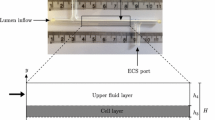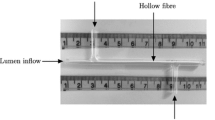Abstract
We present a simplified two-dimensional model of fluid flow, solute transport, and cell distribution in a hollow fibre membrane bioreactor. We consider two cell populations, one undifferentiated and one differentiated, with differentiation stimulated either by growth factor alone, or by both growth factor and fluid shear stress. Two experimental configurations are considered, a 3-layer model in which the cells are seeded in a scaffold throughout the extracapillary space (ECS), and a 4-layer model in which the cell–scaffold construct occupies a layer surrounding the outside of the hollow fibre, only partially filling the ECS. Above this is a region of free-flowing fluid, referred to as the upper fluid layer. Following previous models by the authors (Pearson et al. in Math Med Biol, 2013, Biomech Model Mechanbiol 1–16, 2014a, we employ porous mixture theory to model the dynamics of, and interactions between, the cells, scaffold, and fluid in the cell–scaffold construct. We use this model to determine operating conditions (experiment end time, growth factor inlet concentration, and inlet fluid fluxes) which result in a required percentage of differentiated cells, as well as maximising the differentiated cell yield and minimising the consumption of expensive growth factor.







Similar content being viewed by others
Notes
Personal communication with Dr Marianne Ellis, Centre for Regenerative Medicine, University of Bath.
We note that the values for D and \(C^*\) are for different growth factors; this is due to a scarcity of data as these parameters are rarely quantified experimentally.
References
Abdullah NS, Das DB (2007) Modelling nutrient transport in hollow fibre membrane bioreactor for growing bone tissue with consideration of multi-component interactions. Chem Eng Sci 62(21):5821–5839. doi:10.1016/j.ces.2007.06.024
Arnsdorf EJ, Tummala P, Kwon RY, Jacobs CR (2009) Mechanically induced osteogenic differentiation—the role of RhoA, ROCKII and cytoskeletal dynamics. J Cell Sci 122(4):546–553. doi:10.1242/jcs.036293
Breier G, Albrecht U, Sterrer S, Risau W (1992) Expression of vascular endothelial growth factor during embryonic angiogenesis and endothelial cell differentiation. Development 114(2):521–532
Brouwers JEM, van Donkelaar CC, Sengers BG, Huiskes R (2006) Can the growth factors PTHrP, Ihh and VEGF, together regulate the development of a long bone? J Biomech 39(15):2774–2782. doi:10.1016/j.jbiomech.2005.10.004
Byrne HM, Owen MR, Alarcon T, Murphy J, Maini PK (2006) Modelling the response of vascular tumours to chemotherapy: A multiscale approach. Math Models Methods Appl Sci 16(7S):1219–1241. doi:10.1142/S0218202506001522
Gramer MJ, Poeschl DM (2000) Comparison of cell growth in T-flasks, in micro hollow fiber bioreactors, and in an industrial scale hollow fiber bioreactor system. Cytotechnology 34(1–2):111–119. doi:10.1023/A:1008167713696
Kapur S, Baylink DJ, Lau K-HW (2003) Fluid flow shear stress stimulates human osteoblast proliferation and differentiation through multiple interacting and competing signal transduction pathways. Bone 32(3):241–251. doi:10.1016/S8756-3282(02)00979-1
Keane JT, Ryan D, Gray PP (2003) Effect of shear stress on expression of a recombinant protein by chinese hamster ovary cells. Biotech Bioeng 81:211–220
Knazek RA, Gullino PM, Kohler PO, Dedrick RL (1972) Cell culture on artificial capillaries: an approach to tissue growth in vitro. Science 178(4056):65–67. doi:10.1126/science.178.4056.65
Knazek RA, Kohler PO, Gullino PM (1974) Hormone production by cells grown in vitro on artificial capillaries. Exp Cell Res 84(1–2):251–254. doi:10.1016/0014-4827(74)90403-0
Korin N, Bransky A, Dinnar U, Levenberg S (2009) Periodic “flow-stop” perfusion micro channel bioreactors for mammalian and human embryonic stem cell long-term culture. Biomed Microdev 11:87–94
Lemon G, King JR, Byrne HM, Jensen OE, Shakesheff KM (2006) Mathematical modelling of engineered tissue growth using a multiphase porous flow mixture theory. J Math Biol 52:571–594. doi:10.1007/s00285-005-0363-1
Li W-J, Tuli R, Okafor C, Derfoul A, Danielson KG, Hall DJ, Tuan RS (2005) A three-dimensional nanofibrous scaffold for cartilage tissue engineering using human mesenchymal stem cells. Biomaterials 26(6):599–609. doi:10.1016/j.biomaterials.2004.03.005
Mac Gabhann F, Yang MT, Popel AS (2005) Monte Carlo simulations of VEGF binding to cell surface receptors in vitro. Biochim Biophys Acta Mol Cell Res 1746(2):95–107. doi:10.1016/j.bbamcr.2005.09.004
Martin I, Wendt D, Heberer M (2004) The role of bioreactors in tissue engineering. Trends Biotechnol 22(2):80–86. doi:10.1016/j.tibtech.2003.12.001
Martin Y, Vermette P (2005) Bioreactors for tissue mass culture: design, characterization, and recent advances. Biomaterials 26(35):7481–7503. doi:10.1016/j.biomaterials.2005.05.057
Mayer H, Bertram H, Lindenmaier W, Korff T, Weber H, Weich H (2005) Vascular endothelial growth factor (VEGF-A) expression in human mesenchymal stem cells: autocrine and paracrine role on osteoblastic and endothelial differentiation. J Cell Biochem 95(4):827–839. doi:10.1002/jcb.20462
Meneghello G, Parker DJ, Ainsworth BJ, Perera SP, Chaudhuri JB, Ellis MJ, De Bank PA (2009) Fabrication and characterization of poly(lactic-co-glycolic acid)/polyvinyl alcohol blended hollow fibre membranes for tissue engineering applications. J Membr Sci 344(1–2):55–61. doi:10.1016/j.memsci.2009.07.034
Midy V, Plouet J (1994) Vasculotropin/vascular endothelial growth factor induces differentiation in cultured osteoblasts. Biochem Biophys Res Commun 199(1):380–386. doi:10.1006/bbrc.1994.1240
Mohebbi-Kalhori D, Behzadmehr A, Doillon CJ, Hadjizadeh A (2012) Computational modeling of adherent cell growth in a hollow-fiber membrane bioreactor for large-scale 3-D bone tissue engineering. J Artif Organs 15:250–265. doi:10.1007/s10047-012-0649-1
Obi S, Yamamoto K, Shimizu N, Kumagaya S, Masumura T, Sokabe T, Asahara T, Ando J (2009) Fluid shear stress induces arterial differentiation of endothelial progenitor cells. J Appl Physiol 106(1):203–211. doi:10.1152/japplphysiol.00197.2008
O’Dea RD, Waters SL, Byrne HM (2010) A multiphase model for tissue construct growth in a perfusion bioreactor. Math Med Biol 27(2):95–127. doi:10.1093/imammb/dqp003
Park J, Li Y, Berthiaume F, Toner M, Yarmouth ML, Tilles AW (2008) Radial flow hepatocyte bioreactor using stacked microfabricated grooved substrates. Biotech Bioeng 99:455–467
Pearson NC, Shipley RJ, Waters SL, Oliver JM (2013) Multiphase modelling of the influence of fluid flow and chemical concentration on tissue growth in a hollow fibre membrane bioreactor. Math Med Biol. doi:10.1093/imammb/dqt015
Pearson NC, Waters SL, Oliver JM, Shipley RJ (2014a) Multiphase modelling of the effect of fluid shear stress on cell yield and distribution in a hollow fibre membrane bioreactor. Biomech Model Mechanbiol 1–16. doi:10.1007/s10237-014-0611-7
Pearson NC, Shipley RJ, Waters SL, Oliver JM (2014b) Dispersion-enhanced solute transport in a cell-seeded hollow fibre membrane bioreactor. J Eng Math. doi:10.1007/s10665-015-9819-5
Peters KG, De Vries C, Williams LT (1993) Vascular endothelial growth factor receptor expression during embryogenesis and tissue repair suggests a role in endothelial differentiation and blood vessel growth. Proc Natl Acad Sci USA 90(19):8915–8919
Planchamp C, Vu TL, Mayer JM, Reist M, Testa B (2003) Hepatocyte hollow-fibre bioreactors: design, set-up, validation and applications. J Pharm Pharmacol 55(9):1181–1198. doi:10.1211/0022357021963
Plank MJ, Sleeman BD, Jones PF (2004) A mathematical model of tumour angiogenesis, regulated by vascular endothelial growth factor and the angiopoietins. J Theor Biol 229(4):435–454. doi:10.1016/j.jtbi.2004.04.012
Prabhakaran MP, Venugopal JR, Ramakrishna S (2009) Mesenchymal stem cell differentiation to neuronal cells on electrospun nanofibrous substrates for nerve tissue engineering. Biomaterials 30(28):4996–5003. doi:10.1016/j.biomaterials.2009.05.057
Shipley RJ, Waters SL, Ellis MJ (2010) Definition and validation of operating equations for poly(vinyl alcohol)-poly(lactide-co-glycolide) microfiltration membrane-scaffold bioreactors. Biotechnol Bioeng 107(2):382–392. doi:10.1002/bit.22815
Shipley RJ, Davidson AJ, Chan K, Chaudhuri JB, Waters SL, Ellis MJ (2011) A strategy to determine operating parameters in tissue engineering hollow fiber bioreactors. Biotechnol Bioeng 108(6):1450–1461. doi:10.1002/bit.23062
Shipley RJ, Waters SL (2012) Fluid and mass transport modelling to drive the design of cell-packed hollow fibre bioreactors for tissue engineering applications. Math Med Biol 29:329–359. doi:10.1093/imammb/dqr025
Tharakan JP, Chau PC (1986) A radial flow hollow fiber bioreactor for the large-scale culture of mammalian cells. Biotechnol Bioeng 28(3):329–342. doi:10.1002/bit.260280305
Tourovskaia A, Figueroa-Masot X, Folch A (2005) Differentiation-on-a-chip: a microfluidic platform for long-term cell culture studies. Lab Chip 5:14–19
Wu C-C, Chao Y-C, Chen C-N, Chien S, Chen Y-C, Chien C-C, Chiu J-J, Yen BL (2008) Synergism of biochemical and mechanical stimuli in the differentiation of human placenta-derived multipotent cells into endothelial cells. J Biomech 41(4):813–821. doi:10.1016/j.jbiomech.2007.11.008
Yamamoto K, Sokabe T, Watabe T, Miyazono K, Yamashita JK, Obi S, Ohura N, Matsushita A, Kamiya A, Ando J (2005) Fluid shear stress induces differentiation of Flk-1-positive embryonic stem cells into vascular endothelial cells in vitro. Am J Physiol Heart Circ Physiol 288(4):H1915–H1924. doi:10.1152/ajpheart.00956.2004
Ye H, Das DB, Triffitt JT, Cui Z (2006) Modelling nutrient transport in hollow fibre membrane bioreactors for growing three-dimensional bone tissue. J Membr Sci 272(1–2):169–178. doi:10.1016/j.memsci.2005.07.040
Ye H, Xia Z, Ferguson DJP, Triffitt JT, Cui Z (2007) Studies on the use of hollow fibre membrane bioreactors for tissue generation by using rat bone marrow fibroblastic cells and a composite scaffold. J Mater Sci Mater Med 18(4):641–648. doi:10.1007/s10856-007-2314-4
Acknowledgments
N.C.P. is funded by an Engineering and Physical Sciences Research Council (EPSRC) studentship through the Systems Biology Doctoral Training Centre at the University of Oxford.
Author information
Authors and Affiliations
Corresponding author
Appendix: Dimensionless equations
Appendix: Dimensionless equations
Following the non-dimensionalisation in Sect. 3.2, we present the dimensionless equations in the remaining layers of the modelling domain. Beginning in the lumen, we have
In the porous membrane, the dimensionless equations are
where \(\kappa = k/(\lambda \varepsilon ^5 L^2)\) is the \(\text {O}(1)\) dimensionless permeability (see Table 3). Finally, in the 4-layer model the upper fluid layer equations are
Rights and permissions
About this article
Cite this article
Pearson, N.C., Oliver, J.M., Shipley, R.J. et al. A multiphase model for chemically- and mechanically- induced cell differentiation in a hollow fibre membrane bioreactor: minimising growth factor consumption. Biomech Model Mechanobiol 15, 683–700 (2016). https://doi.org/10.1007/s10237-015-0717-6
Received:
Accepted:
Published:
Issue Date:
DOI: https://doi.org/10.1007/s10237-015-0717-6




